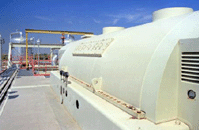Geothermal Energy
The three technology categories for its use are:
Domestic Power from Geothermal Heat Pumps - Use of Shallow Ground Energy to Heat and Cool BuildingsThe earth absorbs almost 50% of all the solar energy that falls on it and remains a nearly constant temperature of 10°C to 16°C depending on geographic location. Working with an underground loop system, geothermal heating and cooling systems utilize this constant temperature to exchange energy between domestic homes and the earth as needed for heating and cooling. In winter, water circulating inside a sealed underground loop system absorbs heat from the earth and carries it to the geothermal unit. Here it is compressed to a higher temperature and sent as warm air to your indoor system for circulation throughout the home. In the summer, the system reverses and expels heat from your home into the cooler earth via the loop system. This heat exchange process is not only natural, but is a natural and highly efficient way to create a comfortable climate in the home. There are several loop options that can be employed. They can either be vertical, horizontal, or submerged in a nearby pond or lake. In many cases, a water well can be used instead. The best application will depend on the characteristics of the property. Direct-Use Piped Hot WaterHot water near Earth's surface can be piped directly into facilities and used to heat buildings, grow plants in greenhouses, warm water for fish farming, and to pasteurize milk. Some cities in the USA pipe the hot water under roads and sidewalks to melt snow. District heating applications use networks of piped hot water to heat buildings in whole communities. Power Plants Generate Electricity from Geothermal Reservoirs
Three types of power plants are operating today:
Domestic geothermal energy use:Links you may find useful:
|
Follow me...
|



 Wells (a mile or more in depth) can be drilled into underground reservoirs to tap steam and very hot water. The pressure from the steam generated by this drives turbines that drive electricity generators.
Wells (a mile or more in depth) can be drilled into underground reservoirs to tap steam and very hot water. The pressure from the steam generated by this drives turbines that drive electricity generators. 


